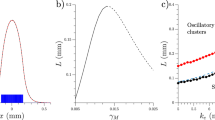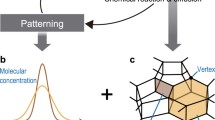Abstract
The culmination of the morphogenesis of the cellular slime mould Dictyostelium discoideum involves complex cell movements which transform a mound of cells into a globule of spores on a slender stalk. We show that cyclic AMP signalling and differential adhesion, combined with cell differentiation and slime production, are sufficient to produce the morphogenetic cell movements which lead to culmination. We have simulated the process of culmination using a hybrid cellular automata/partial differential equation model. With our model we have been able to reproduce the main features that occur during culmination, namely the straight downward elongation of the stalk, its anchoring to the substratum and the formation of the long thin stalk topped by the spore head.
We conclude that the cyclic AMP signalling system is responsible for the elongation and anchoring of the stalk, but in a roundabout way: pressure waves that are induced by the chemotaxis towards cyclic AMP squeeze the stalk through the cell mass. This mechanism forces the stalk to elongate precisely in the direction opposite to that of the chemotactically moving cells. The process turns out to be ‘guided’ by inactive ‘pathfinder’ cells, which form the tip of the stalk. We show that the entire development is enacted by means of the aforementioned building blocks. This means that no global gradients or different modes of chemotaxis are needed to complete the culmination.
MPEG movies of the simulations are available on-line: http://www-binf.bio. uu.nl/stan/bmb.
Similar content being viewed by others
References
Amagai, A., S. Ishida and I. Takeuchi (1983). Cell differentiation in a temperature-sensitive stalkless mutant of Dictyostelium discoideum. J. Embryol. Exp. Morphol. 74, 235–243.
Berks, M. and R. R. Kay (1990). Combinatorial control of cell differentiation by cAMP and DIF-1 during development of Dictyostelium discoideum. Development 110, 977–984.
Blanton, R. L. (1997). Cellulose biogenesis in Dictyostelium discoideum, in Dictyostelium: A Model System for Cell and Developmental Biology, Y. Maeda, K. Inouye and I. Takeuchi (Eds), Tokyo: Universal Academy Press, pp. 379–391.
Bonner, J. T., A. D. Chiquoine and M. Q. Kolderie (1955). A histochemical study of differentiation in the cellular slime molds. J. Exp. Zool. 130, 133–157.
Bonner, J. T. and M. R. Dodd (1962). Aggregation territories in the cellular slime molds. Biol. Bull. 122, 13–24.
Bonner, J. T., H. B. Suthers and G. M. Odell (1986). Ammonia orients cell masses and speeds up aggregating cells of slime moulds. Nature 323, 630–632.
Bozzaro, S. and E. Ponte (1995). Cell adhesion in the life cycle of Dictyostelium. Experientia 51, 1175–1188.
Bretschneider, T., F. Siegert and C. J. Weijer (1995). Three-dimensional scroll waves of cAMP could direct cell movement and gene expression in Dictyostelium slugs. Proc. Natl. Acad. Sci. U.S.A. 92, 4387–4391.
Bretschneider, T., B. Vasiev and C. J. Weijer (1999). A model for Dictyostelium slug movement. J. Theor. Biol. 199, 125–136.
Chen, T.-L. L., P. A. Kowalczyk, G. Ho and R. L. Chisholm (1995). Targeted disruption of the Dictyostelium myosin essential light chain gene produces cells defective in cytokinesis and morphogenesis. J. Cell Sci. 108, 3207–3218.
Chen, T.-L. L., W. A. Wolf and R. L. Chisholm (1998). Cell-type-specific rescue of myosin function during Dictyostelium development defines two distinct cell movements required for culmination. Development 125, 3895–3903.
Clow, P. A., T.-L. L. Chen, R. L. Chisholm and J. G. McNally (2000). Three-dimensional in vivo analysis of Dictyostelium mounds reveals directional sorting of prestalk cells and defines a role for the myosin II regulatory light chain in prestalk cell sorting and tip protrusion. Development 127, 2715–2728.
Dormann, D., B. Vasiev and C. J. Weijer (1998). Propagating waves control Dictyostelium discoideum morphogenesis. Biophys. Chem. 72, 21–35.
Dormann, D., B. Vasiev and C. J. Weijer (2000). The control of chemotactic cell movement during Dictyostelium morphogenesis. Phil. Trans. R. Soc. Lond. B. Biol. Sci. 355, 983–991.
Feit, I. N. and R. B. Sollitto (1987). Ammonia is the gas used for the spacing of fruiting bodies in the cellular slime mold, Dictyostelium discoideum. Differentiation 33, 193–196.
Fontana, D. R. (1995). Dictyostelium discoideum cohesion and adhesion, in Principles of Cell Adhesion, P. D. Richardson and M. Steiner (Eds), Boca Raton: CRC Press, pp. 63–86.
Glazier, J. A. and F. Graner (1993). Simulation of the differential adhesion driven rearrangement of biological cells. Phys. Rev. E 47, 2128–2154.
Grimson, M. J., C. H. Haigler and R. L. Blanton (1996). Cellulose microfibrils, cell motility, and plasma membrane protein organization change in parallel during culmination in Dictyostelium discoideum. J. Cell Sci. 109, 3079–3087.
Harwood, A. J., N. A. Hopper, M.-N. Simon, D. M. Driscoll, M. Veron and J. G. Williams (1992). Culmination in Dictyostelium is regulated by the cAMP-dependent protein kinase. Cell 69, 615–624.
Higuchi, G. and T. Yamada (1984). A cinematographical study of cellular slime molds. I. Stalk and disk formation in Dictyostelium discoideum. Cytologia 49, 841–849.
Höfer, T., J. A. Sherratt and P. K. Maini (1995). Dictyostelium discoideum: cellular self-organization in an excitable biological medium. Proc. R. Soc. Lond. Ser. B 259, 249–257.
Jermyn, K., D. Traynor and J. Williams (1996). The initiation of basal disc formation in Dictyostelium discoideum is an early event in culmination. Development 122, 753–760.
Jermyn, K. A. and J. G. Williams (1991). An analysis of culmination in Dictyostelium using prestalk and stalk-specific cell autonomous markers. Development 111, 779–787.
Jiang, Y., H. Levine and J. Glazier (1998). Possible cooperation of differential adhesion and chemotaxis in mound formation of Dictyostelium. Biophys. J. 75, 2615–2625.
Kawasaki, Y., T. Kiryu, K. Usui and H. Mizutani (1990). Growth of the cellular slime mold, Dictyostelium discoideum, is gravity dependent. Plant Physiol. 93, 1568–1572.
Keller, E. F. and L. A. Segel (1970). Initiation of slime mold aggregation viewed as an instability. J. Theor. Biol. 26, 399–415.
Kessin, R. H. (2001). Dictyostelium: Evolution, Cell Biology, and the Development of Multicellularity, Developmental and Cell Biology Series 38, Cambridge: Cambridge University Press.
Kitami, M. (1984). Chemotactic response of Dictyostelium discoideum cell to c-AMP at the culmination stage. Cytologia 49, 257–264.
Kitami, M. (1985). Motive force of the culminating mass of cells in the developing fruiting body of Dictyostelium discoideum. Cytologia 50, 109–115.
Levine, H. and W. Reynolds (1991). Streaming instability of aggregating slime mold amoebae. Phys. Rev. Lett. 66, 2400–2403.
MacKay, S. A. (1978). Computer simulation of aggregation in Dictyostelium discoideum. J. Cell Sci. 33, 1–16.
Marée, A. F. M. and P. Hogeweg (2001). How amoeboids self-organize into a fruiting body: multicellular coordination in Dictyostelium discoideum. Proc. Natl. Acad. Sci. U.S.A. 98, 3879–3883.
Marée, A. F. M., A. V. Panfilov and P. Hogeweg (1999a). Migration and thermotaxis of Dictyostelium discoideum slugs, a model study. J. Theor. Biol. 199, 297–309.
Marée, A. F. M., A. V. Panfilov and P. Hogeweg (1999b). Phototaxis during the slug stage of Dictyostelium discoideum: a model study. Proc. R. Soc. Lond. Ser. B 266, 1351–1360.
Miura, K. and F. Siegert (2000). Light affects cAMP signaling and cell movement activity in Dictyostelium discoideum. Proc. Natl. Acad. Sci. U.S.A. 97, 2111–2116.
Nanjundiah, V. (1973). Chemotaxis, signal relaying and aggregation morphology. J. Theor. Biol. 42, 63–105.
Odell, G. M. and J. T. Bonner (1986). How the Dictyostelium discoideum grex crawls. Phil. Trans. R. Soc. Lond. Ser. B 312, 487–525.
Palsson, E. and H. G. Othmer (2000). A model for individual and collective cell movement in Dictyostelium discoideum. Proc. Natl. Acad. Sci. U.S.A. 97, 10448–10453.
Panfilov, A. V. and A. M. Pertsov (1984). Vortex ring in a three-dimensional active medium described by reaction-diffusion equations. Dokl. Akad. Nauk SSSR 274, 1500–1503.
Parnas, H. and L. A. Segel (1977). Computer evidence concerning the chemotactic signal in Dictyostelium discoideum. J. Cell Sci. 25, 191–204.
Rubinow, S. I., L. A. Segel and W. Ebel (1981). A mathematical framework for the study of morphogenetic development in the slime mold. J. Theor. Biol. 91, 99–113.
Savill, N. J. and P. Hogeweg (1997). Modeling morphogenesis: from single cells to crawling slugs. J. Theor. Biol. 184, 229–235.
Siegert, F. and C. Weijer (1989). Digital image processing of optical density wave propagation in Dictyostelium discoideum and analysis of the effects of caffeine and ammonia. J. Cell Sci. 93, 325–335.
Siegert, F. and C. J. Weijer (1992). Three-dimensional scroll waves organize Dictyostelium slugs. Proc. Natl. Acad. Sci. U.S.A. 89, 6433–6437.
Siegert, F. and C. J. Weijer (1995). Spiral and concentric waves organize multicellular Dictyostelium mounds. Curr. Biol. 5, 937–943.
Smith, D. (2000). Completed and near-complete 80 REMI genes [online] <www-biology.ucsd.edu/others/dsmith/REMIgenes2000.html>.
Sternfeld, J. (1992). A study of PstB cells during Dictyostelium migration and culmination reveals a unidirectional cell type conversion process. Roux’s Arch. Dev. Biol. 201, 354–363.
Sternfeld, J. (1998). The anterior-like cells in Dictyostelium are required for the elevation of the spores during culmination. Dev. Genes Evol. 208, 487–494.
Takeuchi, I., T. Kakutani and M. Tasaka (1988). Cell behavior during formation of prestalk/prespore pattern in submerged agglomerates of Dictyostelium discoideum. Dev. Genet. 9, 607–614.
Thomason, P., D. Traynor and R. Kay (1999). Taking the plunge. Terminal differentiation in Dictyostelium. Trends Genet. 15, 15–19.
Tyson, J. J. and J. D. Murray (1989). Cyclic AMP waves during aggregation of Dictyostelium amoebae. Development 106, 421–426.
Van Oss, C., A. V. Panfilov, P. Hogeweg, F. Siegert and C. J. Weijer (181). Spatial pattern formation during aggregation of the slime mould Dictyostelium discoideum. J. Theor. Biol. 203–213.
Vasiev, B. and C. J. Weijer (1999). Modeling chemotactic cell sorting during Dictyostelium discoideum mound formation. Biophys. J. 76, 595–605.
Vasiev, B. N., P. Hogeweg and A. V. Panfilov (1994). Simulation of Dictyostelium discoideum aggregation via reaction-diffusion model. Phys. Rev. Lett. 73, 3173–3176.
Verkerke-Van Wijk, I. and P. Schaap (1997). cAMP, a signal for survival, in Dictyostelium: A Model System for Cell and Developmental Biology, Y. Maeda, K. Inouye and I. Takeuchi (Eds), Tokyo: Universal Academy Press, pp. 145–162.
Watts, D. J. and T. E. Treffry (1976). Culmination in the slime mould Dictyostelium discoideum studied with a scanning electron microscope. J. Embryol. Exp. Morphol. 35, 323–333.
Weijer, C. J. (1999). The role of chemotactic cell movement in Dictyostelium morphogenesis, in On Growth and Form: Spatio-temporal Pattern Formation in Biology, Wiley Series in Mathematical and Computational Biology, M. A. J. Chaplain, G. D. Singh and J. C. McLachlan (Eds), Chichester: John Wiley & Sons, pp. 173–199.
Whittingham, W. F. and K. B. Raper (1960). Non-viability of stalk cells in Dictyostelium. Proc. Natl. Acad. Sci. U.S.A. 46, 642–649.
Wilkins, M. R. and K. L. Williams (1995). The extracellular matrix of the Dictyostelium discoideum slug. Experientia 51, 1189–1196.
Williams, G. B., E. M. Elder and M. Sussman (1984). Modulation of the cAMP relay in Dictyostelium discoideum by ammonia and other metabolites: possible morphogenetic consequences. Dev. Biol. 105, 377–388.
Williams, J. (1997). Prestalk and stalk cell heterogeneity in Dictyostelium, in Dictyostelium: a Model System for Cell and Developmental Biology, Y. Maeda, K. Inouye and I. Takeuchi (Eds), Tokyo: Universal Academy Press, pp. 293–304.
Williams, J., N. Hopper, A. Early, D. Traynor, A. Harwood, T. Abe, M. N. Simon and M. Véron (1993). Interacting signalling pathways regulating prestalk cell differentiation and movement during the morphogenesis of Dictyostelium. Development Suppl, 1–7.
Williams, J. G., K. A. Jermyn and K. T. Duffy (1989). Formation and anatomy of the prestalk zone of Dictyostelium. Development Suppl, 91–97.
Zeeman, E. C. (1977). Slime mold culmination, in Catastrophe Theory: Selected Papers, Reading, MA: Addison-Wesley, pp. 216–233.
Author information
Authors and Affiliations
Corresponding author
Rights and permissions
About this article
Cite this article
Marée, A.F.M., Hogeweg, P. Modelling Dictyostelium discoideum morphogenesis: The culmination. Bull. Math. Biol. 64, 327–353 (2002). https://doi.org/10.1006/bulm.2001.0277
Received:
Accepted:
Issue Date:
DOI: https://doi.org/10.1006/bulm.2001.0277




